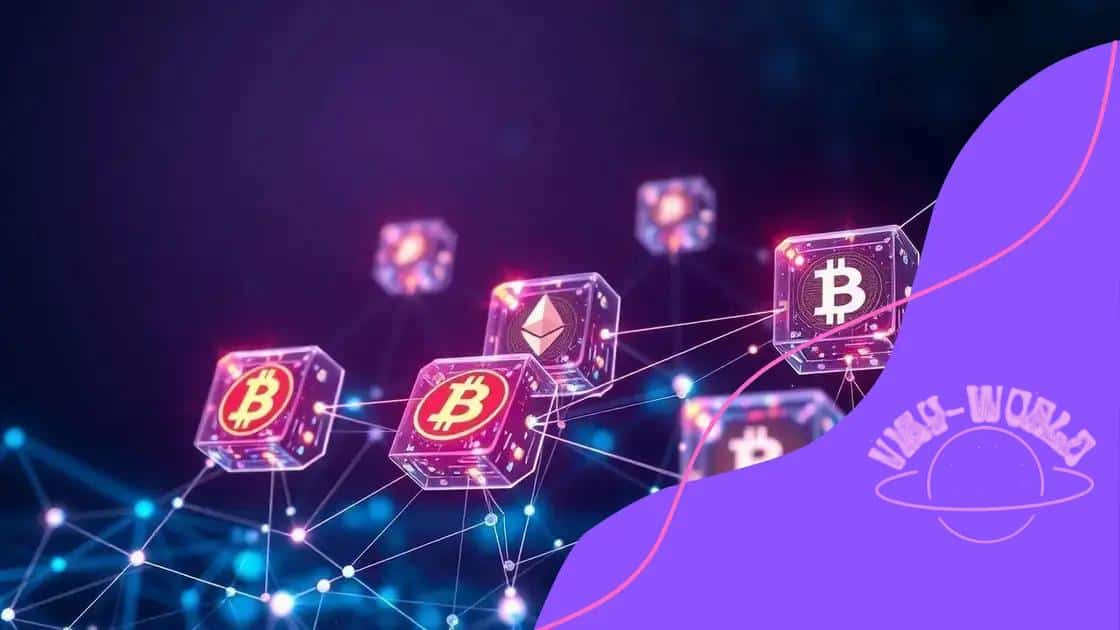Decentralized finance (DeFi) ecosystems: unlocking new possibilities

Decentralized finance (DeFi) platforms enable users to access financial services without intermediaries, promoting accessibility, efficiency, and innovative financial solutions through blockchain technology.
Decentralized finance (DeFi) ecosystems have taken the financial world by storm, creating new opportunities for users and innovators alike. Have you ever wondered how these platforms can change your financial experiences? Let’s dive in!
Understanding decentralized finance and its principles
Understanding decentralized finance (DeFi) is essential for anyone looking to explore modern financial solutions. Essentially, DeFi aims to recreate traditional financial systems using blockchain technology, promoting accessibility and efficiency.
This financial sector is structured around several core principles that make it stand out. By focusing on transparency, inclusivity, and security, DeFi platforms offer unique benefits to users.
Core Principles of DeFi
At the heart of decentralized finance are principles that redefine how we view financial transactions. These principles include:
- Transparency: All transactions are recorded on a public ledger, enabling anyone to verify them.
- Inclusivity: DeFi provides financial services to anyone with internet access, regardless of their location or socioeconomic status.
- Security: Utilizing blockchain technology increases the safety of transactions, making them less prone to fraud.
In addition to these core principles, DeFi promotes a new form of economic interaction. Users can lend, borrow, and trade assets without intermediaries, allowing for lower fees and faster transactions. This encourages a more innovative approach to financial services and can empower individuals like never before.
Benefits of Understanding DeFi
By grasping the concepts behind decentralized finance, individuals can take advantage of numerous opportunities. For example, they can:
- Access a variety of financial services without needing a bank.
- Engage in global markets seamlessly.
- Participate in income-generating activities through yield farming and lending.
As you delve deeper into the world of DeFi, it becomes evident that this movement is reshaping finance. It not only addresses many issues of traditional systems but also presents new challenges and opportunities.
Key components of DeFi ecosystems
The key components of decentralized finance (DeFi) ecosystems are essential for understanding how this innovative sector operates. These components work together to create a flexible and user-friendly financial environment.
One of the most important elements is the smart contract. These are self-executing contracts with the agreement directly written into code. Smart contracts eliminate the need for intermediaries, reducing costs and increasing efficiency.
Essential Elements of DeFi Ecosystems
Another critical component of DeFi is the various decentralized applications (dApps). These applications provide users with services such as trading, lending, and borrowing, all without traditional financial institutions. Here are a few types of dApps:
- Decentralized exchanges (DEXs): Platforms that allow users to trade cryptocurrencies directly.
- Lending platforms: Services where users can lend out their funds for interest.
- Yield farming: A technique where users earn rewards by providing liquidity to DeFi protocols.
Another vital aspect of DeFi ecosystems is their underlying blockchain technology. Most DeFi applications operate on the Ethereum blockchain, which provides a secure and efficient way to manage transactions and protocols. This technology supports the transparency and immutability that users demand.
Interoperability and Tokenization
Interoperability between different platforms is also a significant feature of DeFi ecosystems. This allows various dApps and protocols to work together seamlessly, enhancing user experience. Users can move assets across different platforms quickly and efficiently.
Finally, tokenization plays a crucial role in DeFi. This process converts physical assets into digital tokens that can be traded on blockchain networks. Tokenization opens new avenues for investment and liquidity, making a wide range of assets accessible to more people.
Benefits of using DeFi platforms

Using decentralized finance (DeFi) platforms offers numerous advantages that can significantly enhance financial experiences. These platforms are designed to promote accessibility, efficiency, and innovation in the financial sector.
One of the main benefits of DeFi is accessibility. Anyone with an internet connection can use DeFi platforms, providing opportunities for individuals who may not have access to traditional banking services. This inclusivity opens up new financial possibilities for people all over the world.
Cost Efficiency
Another advantage is the cost efficiency of transactions. Since DeFi platforms eliminate intermediaries, users often pay lower fees compared to traditional financial services. This cost-saving aspect can be especially beneficial for frequent traders and investors.
- Lower transaction fees: Users can save money on trades and loan transactions.
- Fast transactions: Transactions occur quickly, often within minutes.
- Global access: Users can trade and invest from anywhere, without geographical limitations.
Additionally, decentralized finance platforms provide enhanced transparency. All transactions are recorded on the blockchain, allowing users to verify them anytime. This level of transparency builds trust and provides users with confidence in the security of their assets.
Innovation and Flexibility
Another key benefit of DeFi is its focus on innovation. The platforms continuously evolve to offer new products and services, pushing the boundaries of what finance can achieve. Users can participate in innovative activities like yield farming, which allows them to earn rewards by providing liquidity.
Furthermore, DeFi platforms are highly flexible. Users can customize their financial strategies based on their needs and preferences. This adaptability empowers individuals to take control of their finances in ways not possible with traditional systems.
Challenges facing DeFi adoption
While decentralized finance (DeFi) offers many advantages, it also faces several significant challenges that can hinder its adoption. Understanding these challenges is essential for anyone interested in the DeFi space.
One major issue is regulatory uncertainty. Governments around the world are still figuring out how to regulate DeFi platforms. Without clear regulations, users may feel uncertain about the safety of their assets, and platforms may struggle with compliance.
Security Risks
Another obstacle to DeFi adoption is security risks. Although blockchain technology is generally secure, DeFi platforms have been targets for hacks and scams. Smart contracts can have vulnerabilities, which can lead to significant financial losses for users.
- Hack incidents: Several high-profile hacks have resulted in stolen funds.
- DeFi scams: Users must be cautious of fraudulent projects that can lead to financial loss.
- Smart contract flaws: Bugs in code can expose users to risks.
Moreover, there is a steep learning curve associated with using DeFi platforms. Many users find the technology confusing or intimidating, which can discourage them from getting involved. This complexity can be a barrier to entry for potential users who are familiar with traditional finance but not with blockchain technology.
Scalability Issues
Scalability is another challenge faced by DeFi ecosystems. Many platforms experience congestion during high usage times, leading to slow transaction times and high fees. This can frustrate users and drive them back to traditional finance.
Lastly, the multitude of projects in the DeFi space can create confusion. With so many options available, users may struggle to choose platforms that suit their needs best. This overwhelming choice can lead to indecision or poor choices.
Future trends in decentralized finance
The future of decentralized finance (DeFi) is bright, with numerous trends emerging that could transform the financial landscape even further. These trends indicate a shift toward greater innovation, usability, and integration with traditional finance.
One major trend is the increasing integration with traditional financial systems. More banks and financial institutions are exploring ways to incorporate DeFi services, providing a bridge between the conventional financial world and decentralized solutions. This integration can bring legitimacy to DeFi and further increase its user base.
Adoption of Layer 2 Solutions
Another important development is the rise of Layer 2 solutions. These solutions aim to improve the scalability and speed of transactions on existing blockchains, like Ethereum. By reducing congestion and lowering costs, Layer 2 options make DeFi applications more user-friendly and accessible.
- Faster transactions: Users can enjoy quicker processing times, enhancing the experience.
- Lower fees: Costs associated with transactions are significantly reduced, making DeFi more attractive.
- Increased accessibility: Greater ease-of-use encourages more people to participate in DeFi.
Moreover, we can expect to see a rise in compliance and regulatory frameworks for DeFi platforms. As regulators become more familiar with the technology, clearer guidelines will likely emerge. This clarity can help protect users, instill confidence, and encourage broader adoption.
Growth of Decentralized Autonomous Organizations (DAOs)
Additionally, the growth of Decentralized Autonomous Organizations (DAOs) is a trend to watch. DAOs enable users to collaborate and make collective decisions in a decentralized manner. This model promotes community engagement and can lead to more democratic financial systems.
As the DeFi landscape evolves, we may also witness the emergence of new financial products that further innovate how we view finance. These products could include advanced derivatives, insurance solutions, and more comprehensive investment vehicles, all designed to cater to the diverse needs of users.
FAQ – Frequently Asked Questions about Decentralized Finance (DeFi)
What are decentralized finance (DeFi) platforms?
DeFi platforms allow users to engage in financial services without traditional intermediaries, using blockchain technology to enhance accessibility and efficiency.
How does DeFi improve financial accessibility?
DeFi platforms are open to anyone with an internet connection, enabling individuals from all backgrounds to access financial services that may not be available through traditional banks.
What risks are associated with using DeFi platforms?
Users may face security risks from hacks, regulatory uncertainty, and the complexity of navigating decentralized applications.
What trends are shaping the future of DeFi?
Key trends include the integration with traditional finance, the rise of Layer 2 solutions for improved scalability, and the growth of Decentralized Autonomous Organizations (DAOs) that encourage community governance.





